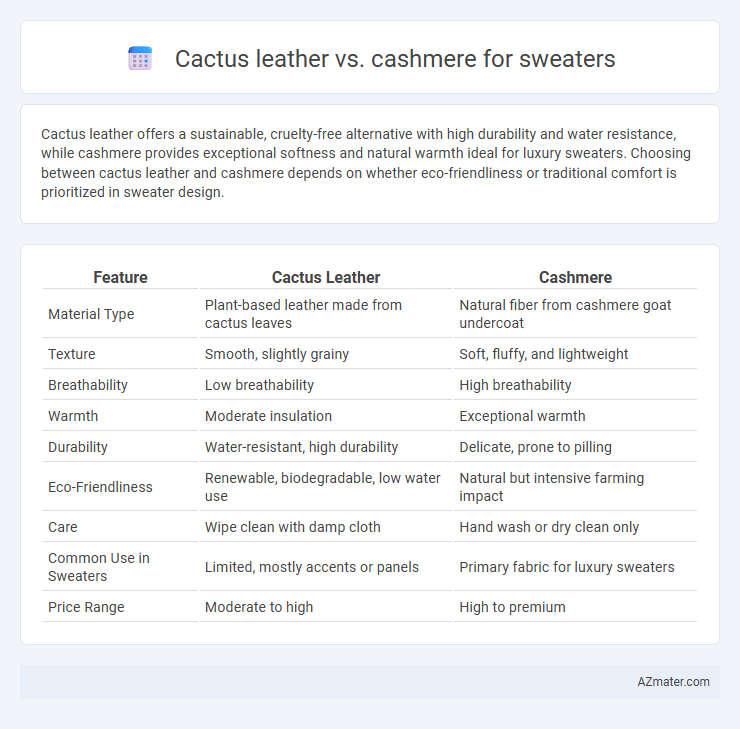Cactus leather offers a sustainable, cruelty-free alternative with high durability and water resistance, while cashmere provides exceptional softness and natural warmth ideal for luxury sweaters. Choosing between cactus leather and cashmere depends on whether eco-friendliness or traditional comfort is prioritized in sweater design.
Table of Comparison
| Feature | Cactus Leather | Cashmere |
|---|---|---|
| Material Type | Plant-based leather made from cactus leaves | Natural fiber from cashmere goat undercoat |
| Texture | Smooth, slightly grainy | Soft, fluffy, and lightweight |
| Breathability | Low breathability | High breathability |
| Warmth | Moderate insulation | Exceptional warmth |
| Durability | Water-resistant, high durability | Delicate, prone to pilling |
| Eco-Friendliness | Renewable, biodegradable, low water use | Natural but intensive farming impact |
| Care | Wipe clean with damp cloth | Hand wash or dry clean only |
| Common Use in Sweaters | Limited, mostly accents or panels | Primary fabric for luxury sweaters |
| Price Range | Moderate to high | High to premium |
Introduction: Cactus Leather and Cashmere Sweaters
Cactus leather sweaters offer a sustainable, vegan alternative to traditional cashmere, combining durability with a soft texture. Cashmere sweaters, known for their luxurious warmth and softness, come from the fine undercoat of cashmere goats. Both materials cater to different consumer values, with cactus leather emphasizing eco-friendly innovation and cashmere focusing on classic comfort and premium quality.
Material Origins: Nature vs. Animal Fibers
Cactus leather is an innovative, plant-based material derived from the prickly pear cactus, offering a sustainable and cruelty-free alternative to traditional textiles. Cashmere, sourced from the soft undercoat of Cashmere goats primarily in Mongolia and China, provides luxurious warmth and softness but involves animal fiber harvesting. Choosing between cactus leather and cashmere highlights a contrast between eco-friendly, renewable botanical fibers and prized animal-derived wool known for its natural insulation properties.
Production Process and Sustainability
Cactus leather is produced through an eco-friendly process that involves harvesting mature nopal cactus leaves, drying them in the sun, and then processing the fibers into a durable, vegan material requiring minimal water and no toxic chemicals. Cashmere production involves shearing the undercoat of cashmere goats, a process demanding intense grazing that can contribute to land degradation and requires significant water use for fiber processing. Cactus leather offers a more sustainable and water-efficient alternative to cashmere, reducing environmental impact through renewable plant-based sourcing and lower resource consumption.
Environmental Impact Comparison
Cactus leather, made from sustainable nopal cactus plants, significantly reduces water consumption and carbon emissions compared to traditional cashmere production, which demands large amounts of water and land for goat grazing. Cashmere goats contribute to severe land degradation and desertification due to overgrazing, resulting in long-term ecological damage. Choosing cactus leather for sweaters supports environmentally responsible fashion by minimizing resource use and habitat destruction.
Texture and Comfort: Feel on the Skin
Cactus leather offers a smooth, slightly firm texture that mimics traditional leather but remains breathable and hypoallergenic, providing a unique tactile sensation on the skin. Cashmere, renowned for its ultra-soft, lightweight fibers, delivers exceptional warmth and a luxurious, plush feel that gently caresses the skin without irritation. While cactus leather emphasizes durability and eco-friendly appeal, cashmere prioritizes unparalleled softness and cozy comfort ideal for sweaters.
Warmth and Insulation Properties
Cactus leather offers moderate insulation and breathability but lacks the superior warmth retention found in cashmere fibers. Cashmere, sourced from the undercoat of cashmere goats, provides exceptional thermal insulation due to its fine, dense wool structure, making it ideal for cold-weather sweaters. While cactus leather suits lightweight, sustainable fashion, cashmere remains the preferred material for warmth and insulation in premium sweaters.
Durability and Maintenance Needs
Cactus leather offers high durability with resistance to wear, scratches, and water, making it a low-maintenance alternative to traditional materials for sweater patches or accents. Cashmere, although renowned for its softness and warmth, requires delicate care including gentle hand washing and storage to prevent pilling and fiber damage. Choosing cactus leather reduces maintenance efforts while cashmere demands more attention to preserve its luxurious texture over time.
Ethical Considerations: Vegan vs. Animal-derived
Cactus leather offers a vegan alternative to cashmere, eliminating harm to animals and reducing the ethical concerns associated with animal-derived fibers. Cashmere, sourced from goats, raises issues such as animal welfare, overgrazing, and environmental degradation linked to traditional farming practices. Choosing cactus leather for sweaters supports cruelty-free fashion and aligns with sustainable, plant-based material trends in the textile industry.
Style, Versatility, and Fashion Appeal
Cactus leather sweaters offer a modern, eco-friendly style that appeals to fashion enthusiasts seeking sustainable alternatives with a unique texture and sleek finish. Cashmere sweaters provide timeless elegance and unmatched softness, making them a versatile wardrobe staple suitable for both casual and formal looks. While cactus leather emphasizes innovative fashion-forward appeal, cashmere remains a classic symbol of luxury and comfort, catering to diverse style preferences.
Price Point and Consumer Accessibility
Cactus leather sweaters generally offer a more affordable price point compared to cashmere, making them accessible to a broader range of consumers seeking sustainable fashion options. Cashmere sweaters, known for their luxury and softness, come at a significantly higher cost due to the labor-intensive production and high-quality raw materials. The accessibility of cactus leather aligns with eco-conscious buyers looking for cruelty-free alternatives, while cashmere remains favored by consumers prioritizing traditional luxury and warmth.

Infographic: Cactus leather vs Cashmere for Sweater
 azmater.com
azmater.com